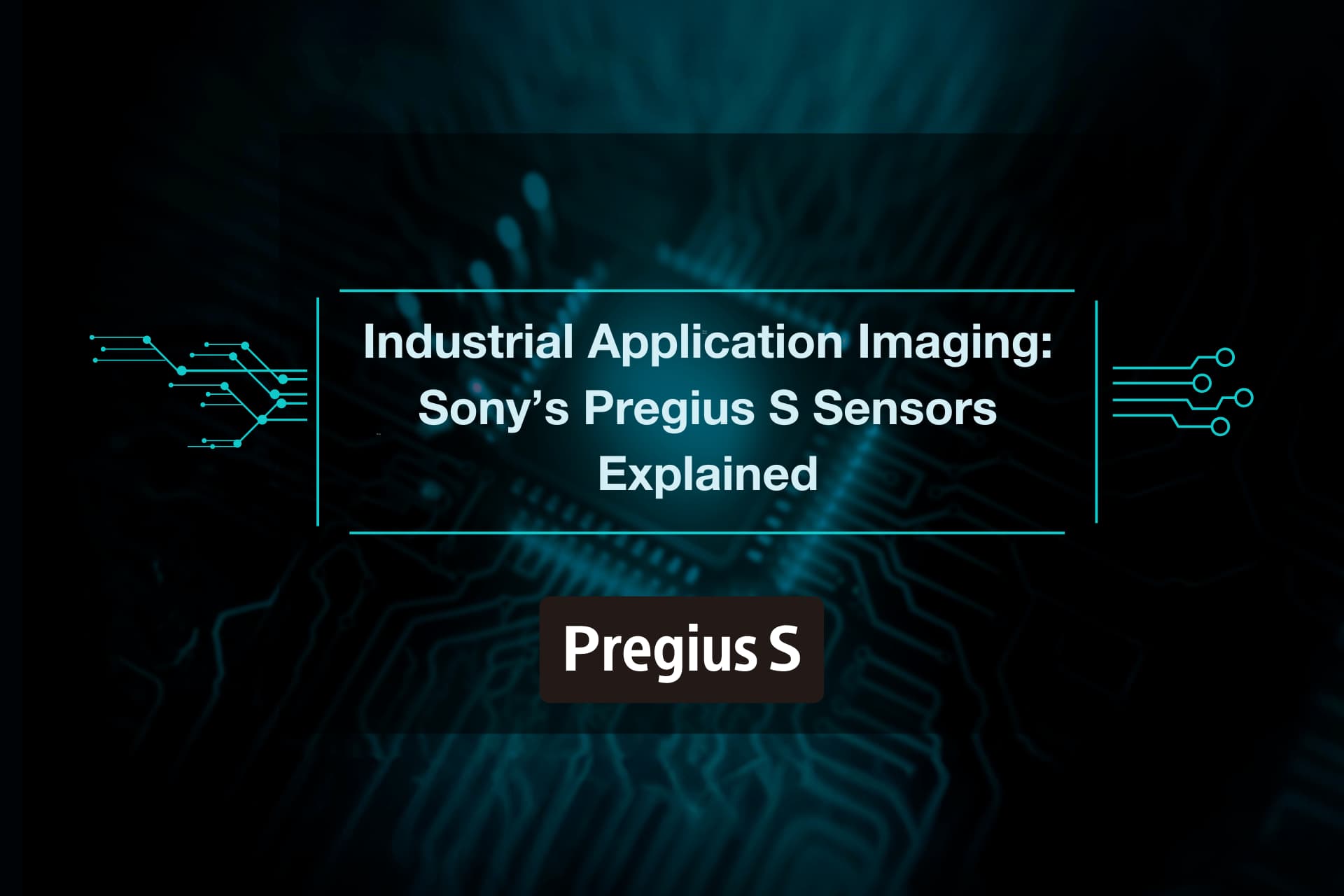Sony introduced its 4th generation global shutter sensor lineup with Pregius S technology a few years ago. This group of sensors are their first global shutter type featuring back-side illuminated pixel and stacked logic. They include the following sensor models:
What you may not know about these sensors is how they can save on overall system costs while providing great quality images. This article is going to focus on the many features of these sensors and how they add value while reducing BOM costs to the latest vision systems.
Overview of Pregius S Features
Before going into their benefits, let us look at what new features have been introduced in these sensors. Their very small, 2.74µm, pixel architecture allows for much larger resolution images to be captured while still being small enough to use lower cost C-Mount lenses. In the past, a system designer would need to look at a large format sensor to get the same resolution that these compact imagers now provide.
These higher resolution sensors, with their larger size, were more expensive and also required larger optics such as bayonet style lenses. Now with the Sony Gen 4 image sensors, engineers can utilize standard, lower cost C-Mount lenses that are common in industrial applications that are much smaller than their bayonet style cousins making overall systems compact yet allow them to fit into tighter spaces. These imagers can easily fit into the typical 29mm x 29mm camera format commonly found in many industrial applications. Larger resolutions also mean that they can cover a larger field of view and/or provide more detail in their snapshots so fewer cameras/images are required to see bigger areas or larger targets in greater detail.
This is key for traffic applications that need to span multiple lanes of traffic that are moving at high speeds with only one camera, or to clearly capture players on a large playing service for sports analytics and video replays.
High-Speed Data Interfaces
With these higher resolution images, the next big challenge to overcome is how to transmit all this data out of the sensor quickly and at high frame rates. Sony decided to use its SLVS-EC protocol to implement the high-speed data interfaces for transmitting the image data.
These imagers use a 5Gbps/lane interface across up to 8 lanes to transmit large images captured with high frame rate to backend processors, such as FPGAs and ISPs. They run twice as fast compared to previous generation of Sony Global shutter sensors. 2.4 times faster than conventional image sensors on the market. Additionally, since SLVS-EC interface has embedded clock (the clock signals are overlayed on top of the image data), fewer PCB tracks are needed on the sensor boards. The data receivers recover the clock from the data streams and generate the clock timing that will be used to extract the pixel values from the device’s data bus.
This method of overlaying the clock timing on top of the data provides faster information throughput over traditional implementations using a separate data bus and clock signals lanes. High speed transceivers built into the FPGAs and ISPs are connected to the SLVS-EC output lanes of the imager and logic inside these devices decode and generate the clock signals needed to then decode the data from the streams. No additional hardware is needed to manage the high data rates while making the PCB layouts more compact and easier to design as there are fewer tracks needed to connect the sensor to these devices, with less meandering required to ensure equal track lengths for all SLVS-EC lanes on the PCB.
Finally, the SLVS-EC protocol incorporates built-in error correction (ECC and CRC features) into the data stream that allows it to correct itself when issues arise. Additional control bits are included in each byte of pixel data to ensure that they are read correctly by the receiver or corrected accordingly to ensure that images are defect free.
Better Images with More Useful Information
As these are stacked sensors, more of the front facing pixel area has been devoted to the photodiode. This provides better sensitivity and color response in captured images, with much less noise than before. All the pixel control circuitry is below the photodiodes. In this design, Sony was able to add in additional circuitry to provide even more functionality that is built right in, with no need for additional processing externally.
Additionally, users can set up the sensor to work in Dual-Gain HDR mode. When activated, all the photo-generated electrons can now be sampled by two different ADCs (analog to digital convertors) which are set up for two different analog gains. This allows the sensor to produce higher dynamic range images by applying high and low gains on the same capture. These images can be combined within the sensor or can be sent to the back-end processing unit (FPGA, ISP chip etc.) for HDR combination.
Versatile Interface Options
MIPI interfaces are fairly common data interface for sensors in vision systems. They provide a standard interface for connecting imagers to many ISPs, FGPAs and processors. Though it is not always fast or large enough to handle the full bandwidth of these Pregius S sensors running at their full resolutions and full speeds, there are cases where having a MIPI interface makes sense. Applications that only need images periodically can leverage the ease of design and implementation that MIPI interfaces provide.
The Embedded System version of the 4th Gen global shutter sensors provide MIPI and SLVS-EC interfaces. This allows them to directly connect to many ISPs readily available on the market through their MIPI interface. AI based applications needing a large resolution global shutter image can take advantage of these sensors and implement their trained AI models on these ISPs to output the results they need making them ideal for System on Module (SoM) or System on Chip (SoC) based designs. Smaller, handheld devices, such as ophthalmic or flow cytometry devices, can provide clues or diagnosis to the operator of potential diseases or issues to be addressed.
New Pregius S Functions
These Pregius S sensors come with many of the functions available in previous generations. On top of them, this generation of sensors have four new functions worthy of mention and explanation.
Short Interval Shutter
One of these new features is the ability to capture two triggered images very quickly. The Short Interval Shutter function allows a camera designer to capture two snapshots that are synchronized to a trigger source and a flash with a very small interval between them. The two images can be captured as quickly as 2µs of each other allowing the camera to capture very small changes in movement. This feature was common on many CCD based sensors but is unique with CMOS based ones.
Applications that can benefit from this feature include fluid flow metering equipment and flow cytometry, sports analytics like golf ball tracking, astronomy and meteor tracking, traffic monitoring, and red light and speed enforcement.
Time-Synchronized Exposure
Another new feature is having a dedicated output pin on the sensor that provides a signal noting the exact time when pixels are exposed to light. This signal goes high when the sensor has started its integration for each image and then goes low once the exposure time is reached. This is beneficial in applications where there is high movement, either by the camera itself or the targets, or when trying to synchronize the exposure with external events or strobe lights.
Under these conditions, the vision system can ensure that the camera on a robotic arm is still and that the target object is not moving so that blur-free images can be captures that are well illuminated. Once the exposure is complete, the robot can then move quickly during the non-exposure period to setup for the next shot, by taking advantage of this dead time to reposition and keep the overall throughput very high.
Tracking ROI (Region of Interest)
Packages moving down a conveyor belt can be tricky to capture their information and bar codes an image. The goal of this system is to run the conveyor as fast as possible to maintain a high throughput of packages while accurately collection information on the labels either encoded on a barcode or printed as a text. Often a camera requires a larger field of view to cover the entire area where this box might be to ensure the important information is captured. To achieve this, the system integrator tries to setup the camera with the smallest ROI possible to ensure that all possible representations of the package can be seen. On top of that, the camera is set to run at its fastest frame rate while reducing all unwanted data to reduce needless processing. Unfortunately, the packages do not always cooperate so the camera is setup with a larger image size, slowing down the overall achievable throughput. This latest Pregius S feature helps address this.
The Tracking ROI feature allows the system integrator to set a smaller ROI in the camera to capture the packages. The sensor then monitors this region for changes in the data. When there are no changes in the data, it simply outputs the ROI image it sees. However, if it detects that there is movement, say a package is coming into the field of view of the ROI, the sensor’s intelligence will move this ROI region on the sensor to follow the target package is seen on the sensor array.
This produces images with a complete view of the package without any manual interventions. This ensures that only the necessary image data is captured at any time, speeding up the frame rate of the camera while reducing the processing time needed to analyse each image.
Motion Detection
Another useful feature that has been added to some of the Sony 4th Gen global shutter sensor is motion detection. It uses a similar algorithm as the Tracking ROI that was described above. The difference here is that the sensor will only output images once it detects that there is movement in the image. In this case, the sensor captures a reference image and stores it in the sensor’s memory.
From there, pixel by pixel analysis is done to see if there are any changes in intensity, which denotes that there is movement in the scene. When there is no movement from the previous capture, no image is outputted by the sensor. Once the sensor intelligence detects these changes, it starts to output images denoting the changes to the scene. It will continue to do this until there is no change between two frames.
This unique feature can be used in applications that require the need to detect changes in subsequent frame like those in factory automation detecting the presence/absence of foreign objects, in security to monitor the presence of a valuable object like a painting, or in flat panel inspection to detect a flaw in the display of the monitor or TV.
Conclusion
As it can be seen, the applications that can benefit from Pregius S based sensors are numerous. Their compact form with large resolutions allow them to be used in more demanding environments while keeping their smaller form factor. This makes them a more economical solution for high speed, high frame rate, large resolution applications due to their smaller sizes and their C-Mount lens compatibility.
FRAMOS can work with you to assess your needs and provide additional value-added support and solutions that can further improve your COGS of your vision system or camera module. Reach out to us at your earliest convenience to learn more about how these new Sony imagers and FRAMOS’s vision experts and products can save you much more on your next global shutter-based application.











